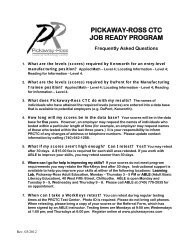Commons
Conceptual Physics - elearning-phys
Conceptual Physics - elearning-phys
- No tags were found...
You also want an ePaper? Increase the reach of your titles
YUMPU automatically turns print PDFs into web optimized ePapers that Google loves.
amplitude, A. The definition of amplitude depends on the systembeing discussed, and two people discussing the same system maynot even use the same definition. In the example of the block onthe end of the spring, 8.1/1, the amplitude will be measured indistance units such as cm. One could work in terms of the distancetraveled by the block from the extreme left to the extreme right, butit would be somewhat more common in physics to use the distancefrom the center to one extreme. The former is usually referred to asthe peak-to-peak amplitude, since the extremes of the motion looklike mountain peaks or upside-down mountain peaks on a graph ofposition versus time.In other situations we would not even use the same units for amplitude.The amplitude of a child on a swing, or a pendulum, 8.1/2,would most conveniently be measured as an angle, not a distance,since her feet will move a greater distance than her head. The electricalvibrations in a radio receiver would be measured in electricalunits such as volts or amperes.In many physical examples of vibrations, the force that bringsthe vibrating object back to equilibrium gets stronger and strongeras the object gets father and farther from equilibrium, and the forceis directly proportional to the distance from equilibrium. Mostsprings behave this way, for example, so for example we’d expectthat the spring in figure 8 would make very nearly twice the forcewhen stretched twice as much. We then define a spring constant,,which tells us how many newtons of force we get per meter of stretching.For example, the John Hancock Tower has a spring constant ofabout 200 MN/m (meganewtons per meter), meaning that the windmust exert a force of about 200 MN in order to make the tower swayby one meter. To make it sway by two meters, the force would haveto be 400 MN.When the force has this type of mathematical behavior, the resultingmotion is known as simple harmonic motion. One surprisingand useful fact about simple harmonic motion is that its frequencyis independent of amplitude. Intuitively, we would expect that vibrationswith a greater amplitude would take more time, i.e., have alower frequency. However, when the amplitude is greater, the forceaccelerating the mass back toward the equilibrium position is alsogreater, and this turns out to compensate exactly for the need totravel a greater distance. Legend has it that Galileo first noticedthis fact when he watched a chandelier swinging during a churchservice, and timed it against his pulse. Mathematically, the frequencyof vibration is given by f = (1/2π) √ k/m, where k is thespring constant, and m is the mass that is vibrating.c / The John Hancock Towerin Boston vibrates naturally at afrequency of 0.14 Hz. Surprisingly,this frequency is the sameregardless of the amplitude of thevibrationsSection 8.1 Vibrations 165



